Today, in many regions of the country, the question remains of how to make heating country house without gas. Natural gas, as everyone knows, is the most inexpensive type of fuel in our country, because... does not require huge amounts of money to extract, deliver and process it.
We, city dwellers, can no longer imagine how we can live without gas. But, despite the fact that Russia is almost the main exporter of “blue fuel”, within the country these benefits of civilization do not reach everyone.
We have many regions where the use of gas is the dream of more than one generation of people living there. What to do if gas is simply not available as a means of heating your country house? Of course, the only way out of the situation is to look for alternative heating methods.
Let's look at some of them, the most realistic ones, and then turn to the numbers, by correlating them, you can make your choice.
The first thing that comes to mind is the usual wood stove, a shortage of which in rural areas does not seem to be observed. Yes, and there will always be conditions for drying and storing firewood. A stove, compared to a boiler, attracts not only its ability to heat a house, but it can also be used to cook food, this is also important.
It does not require gas, electricity or any liquid fuel to operate. A simple and easy to manufacture, operate and maintain heating device. It is enough to clean a wood-burning stove once every two to three weeks, and that’s it.
Oven "Professor Butakov"
its design is somewhat different from traditional types ovens: it retains heat longer, and cooking food on it is much more convenient. Currently, its owners use it as a very important detail interior of a private house.
The next alternative to heating a country house with gas is solid fuel boiler.
They are:
- pyrolysis
- classic
- gas generators
The principle of operation of such a heater is that heat passes through the entire heating system, heating up in the heating source (boiler). Such systems are quite easy to install and are not very expensive. Unlike stoves, solid fuel boilers usually have a safety system.
Solid fuel boilers are made of special heat-resistant steel or cast iron. For its operation, the following are used: firewood, peat, wood waste (sawdust), etc. The cost of heat energy generated will be 10 times lower than when using a liquid fuel boiler, and 16 times lower than an electric boiler.
The solid fuel boiler is efficient in operation, does not require connection to gas or electricity, and is simple and reliable in operation. Disadvantages: loading fuel into the boiler must be done manually; the boiler requires constant human control.
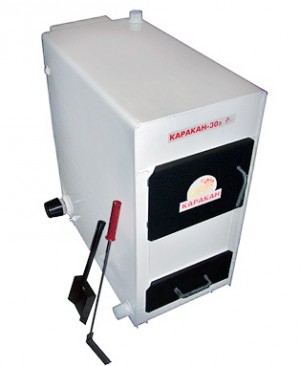
Solid fuel boiler "Karakan"
Liquid fuel boilers have high rate efficiency, which determines the possibility of their use in large areas. Can an oil-fuel boiler be regarded as a cheap alternative source of heating? No, unfortunately.
, kerosene, diesel fuel - all this is not cheap.
Also, to place an oil-fuel boiler, you must have a well-ventilated room; you must strictly follow fire safety rules, as, indeed, when working with any structure that runs on liquid fuel. I will add, unlike solid, liquid fuel needs constant heating and storage in a heated place.
Electric boiler, like liquid fuel, is attractive in quality alternative way heating a private country house due to its very high efficiency. Unlike liquid fuel, it does not disturb the environmental balance, it does not require constant presence, is compact and requires minimal maintenance costs.
But in some regions of the country, power outages are not uncommon, and this factor will require either the purchase or availability of a backup heating device. But the most significant disadvantage of an electric boiler is the cost of electricity; the larger the house, the higher the electricity fee. Yes, and the installation of the equipment itself cannot be called cheap.
One of the most modern developments in the field of alternative heating of a country house without gas has become the development and implementation into practical reality heat pump. It extracts heat from the ground, taking into account the temperature difference in different layers of the earth, as well as from air and water.
To clearly prove the effectiveness of this modern design, I will give you just one figure: 1 kW of heat pump power produces about 6 kW of useful power. The only drawback is its price. Just installing the circuit of such a pump will cost your budget about 0.5 million rubles.
Solar panels, converting solar energy into heat energy. The environmental friendliness of this design is obvious, but there are also quite a few disadvantages.
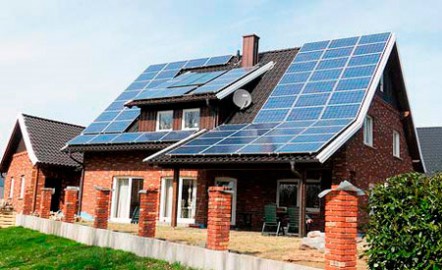
Solar collectors on the roof of a house
Firstly, the work of collectors depends on the weather, which is very important in our capricious climate. Somewhere in the mountains, not forgotten by the Sun, this heating method can be considered in the absence of gas.
Secondly, installation and the need to create high-quality insulation makes the structure very expensive.
Comparison of popular home heating methods in numbers
So, very briefly, without in-depth analysis, we will look at the main types of heating a country house without gas. Which alternative should you choose for yourself?
We will calculate heat energy in gigacalories and determine how much 1 Gcal/hour would cost for your home. For example, to provide heat to a room of 150 m2, you need to spend 16 Gcal in one heating season, i.e. about 2.5 Gcal per month.
To find out the price of 1 Gcal let's use the comparison method. This will allow you to calculate the feasibility of purchasing one or another heating device for your home in the absence of gas. Let's start with it so that it is convenient to compare.
1. Natural gas
Inexpensive type of fuel, cost 1 m2 = 4 rubles. The specific heat of 1 m3 of gas mixture (the gas consists of it) is approximately 7.5 -9.6 thousand Kcal. The efficiency of a boiler operating on gas is about 90%. 1 Gcal of heat will cost 700 rubles. Note that bottled gas costs several times more than natural gas.
2. Liquid fuel
The efficiency of such a boiler is 90%. The price per liter of diesel fuel is approximately 35-40 rubles, and 1 Gcal costs 3,500 rubles. This is expensive, taking into account the fact that diesel fuel prices are not decreasing, but only increasing.
3. Coal
The price is quite low, the efficiency is about 80%, 1 ton of coal costs 6,000 rubles. Specific heat in the region of 5300-5800 Gcal/hour, i.e. 1 Gcal will cost about 1300 rubles.
4. Peat
It is more expensive than coal, having a calorific value of 4000 Gcal/hour, the cost of 1 Gcal is about 1400 rubles.
5. Electricity
One hundred percent efficiency, 1 Gcal is 1163 kW/h. Taking the cost of electricity in the private sector at 2 rubles/kW, 1 Gcal will cost 1,600 rubles.
6. Heat pump
Very expensive to use. But its cost can be reduced through proper installation and proper operation. The principle of its operation can be imagined by comparing it with the operation of a refrigerator - this is the evaporation of refrigerant at a low temperature. The so-called “path” for the pump consists of tubes laid at the bottom of the pond or in the soil of the earth.
If you correctly calculate the depth of these pipes, they will not freeze. As the refrigerant moves toward your vacation home, it will transfer all the heat it extracted from the ground to your heating system. The compressor that controls this movement runs on electricity. To produce 1 kW of heat, you need to spend 300 W. And 1 Gcal of heat will cost about 900 rubles.
Compare these figures and see for yourself that the most affordable method of heating a house without gas is a solid fuel boiler and a modern one. Watch the video: review from a heat pump owner.
The number of country houses and cottages is growing every year: life in major cities tires many people, but for others it is simply beyond their power financial point view, which is why people move out of town. Unfortunately, natural gas is not supplied to all towns and villages in our country, and the issue of heating in such places is more than relevant.
How to heat a house if there is no gas?
However, even if there is gas close to the house, its supply to the house, equipment for the heating system, costs so much money today that, willy-nilly, you begin to think about alternative options. Moreover, there are many options, and many of them successfully combine the experience of previous generations and modern technologies.
Today there are completely exotic methods of heating houses without using natural gas. For example, in the West, options using the so-called heat pump are becoming increasingly popular. The system works by compressing the liquid contained in it, which, from compression, heats up and in this form is supplied to the house. Heat pumps obtain heat from water, air and even from the ground.
Heat pump equipment is extremely expensive, so only people with large financial resources seriously consider this heating option.
In our country, more reliable methods of heating a private house without gas are popular: heating with electricity, diesel fuel and various types solid fuel. We will talk about these methods in this article.
Using an electric boiler
An electric boiler operates in almost the same way as any other heating boiler. The only difference is that the coolant (water) is heated in a steel heat exchanger equipped with thermal electric heating elements (heating elements). Boilers with electronic controls are more economical, making it possible to smoothly adjust the power. Remote thermostats and special programmers help change temperature regime indoors in accordance with a given schedule.
Advantages of heating with electricity:
- Environmentally friendly (completely free of any emissions).
- Not high cost equipment.
- Easy installation.
- Ease of use: an electric boiler does not require a separate room; some models can simply be hung on the wall, as they are very compact. When there is a power outage, the boiler automatically turns off.
Cons:
- The electrical power allocated in the house may not be enough for the boiler to fully operate. It should be remembered that for heating square meters a power of ten kilowatts is required, for two hundred meters, respectively, twice as much. Alas, the allocated power in most private houses does not even reach ten kilowatts, so it will not be possible to heat a cottage with an electric boiler.
- The installation of a boiler with a power above ten kilowatts must be coordinated with electricians.
- In areas with frequent power outages, an electric boiler is of little use.
- The main disadvantage of heating with electricity: high cost. Everyone knows that electricity prices in our country are constantly rising.
Not a bad alternative electric boilers so-called heat convectors are considered.
These are heating devices that operate on air, which circulates inside the device, heating through a heating element.
Autonomous water heating using diesel fuel
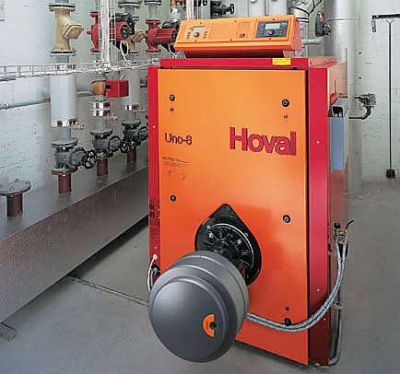 Boilers running on diesel fuel (diesel fuel) are called liquid fuel boilers. However, this type also includes boilers running on kerosene, other petroleum products and even rapeseed oil.
Boilers running on diesel fuel (diesel fuel) are called liquid fuel boilers. However, this type also includes boilers running on kerosene, other petroleum products and even rapeseed oil.
Advantages of heating using diesel fuel:
- High boiler performance (device efficiency hot water type is at least ninety-two percent: this efficiency is sufficient to heat a large building).
- Installation of a diesel fuel boiler, unlike a natural gas boiler, does not require many approvals and permits.
Cons:
- High fire hazard of diesel fuel.
- Environmental problems.
- Diesel fuel is difficult to store. Most often, diesel fuel is kept in specially equipped steel containers and pits.
- The cost of fuel is by no means cheap.
- Difficulty in delivering diesel fuel.
An important additional benefit of heating country house without gas on diesel fuel - the opportunity, if necessary, without significant financial investments, to switch from diesel fuel to main gas. The transition occurs by simply replacing the burner on the heating boiler: a complete reinstallation of the equipment is not required, which saves both money and time.
Heating “the old fashioned way” - wood or coal
 Heating with wood or coal has by no means lost its relevance, and this despite a very wide choice various types fuel. Either old-style stoves or modern solid fuel boilers are used directly for heating.
Heating with wood or coal has by no means lost its relevance, and this despite a very wide choice various types fuel. Either old-style stoves or modern solid fuel boilers are used directly for heating.
Wood-burning stoves have been used in our country for centuries. The principle of operation is the simplest: firewood is placed in the firebox, burned, the walls of the stove heat up, slowly releasing heat into the room. And today this kind of heating “scheme” is very common.
You shouldn’t think that a good old stove doesn’t have advantages; it does have them.:
- The oven heats up quickly.
- No pipes or radiators are needed for heating.
- The sizes of modern stoves are perfect for country houses.
- You can cook food on a wood stove.
- Ecological cleanliness.
Of course, the stove also has obvious disadvantages:
- Old stoves are very bulky and take up a lot of space.
- It is constantly necessary to replenish the supply of firewood.
- The stove must be built from non-combustible materials and equipped with a high-quality chimney.
- Wood combustion products can be dangerous to humans.
- Uneven heating of the room.
However, you can burn wood and coal not only in the stove. Today there are many options for modern solid fuel boilers that heat the coolant - water, and with the help of radiators, distribute it throughout the house. Solid fuel boilers come in three types: classic, pyrolysis and gas generator. Gas generators are considered the most advanced, but they are more demanding on fuel and are more expensive. There are also boilers universal type, capable of operating on several types of fuel. For example, you can switch from coal to diesel fuel.
Advantages of solid fuel boilers:
- Low heating costs.
- System security.
Cons:
- Quite complex operation: “turn on the boiler and forget” will not work. A solid fuel boiler is loaded with fuel from two to six times a day, or even more often (for large, expensive models).
- The boiler needs to be cleaned - remove remaining fuel, clean the combustion chamber from tar, tar, etc. The boiler is cleaned several times a month.
- For normal functioning system requires a high-quality chimney with excellent draft. For pyrolysis solid fuel boilers, only dry firewood is needed - no more than 20 percent humidity.
- Boilers require a long warm-up period and, when fully loaded, cannot reach operating conditions for a long time. full power. After switching off, the solid fuel boiler continues to generate heat for a long time.
Using pellets - does it make sense?
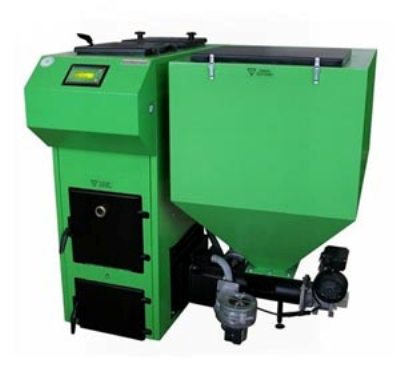 Pellets belong to the category of alternative energy sources. These fuel pellets are made from wood waste(sawdust, shavings), or from agricultural waste. Pellets are cylindrical granules obtained by pressing crushed plant waste.
Pellets belong to the category of alternative energy sources. These fuel pellets are made from wood waste(sawdust, shavings), or from agricultural waste. Pellets are cylindrical granules obtained by pressing crushed plant waste.
Each granule has a length of ten to thirty millimeters and a diameter of six to ten millimeters.
Pellet boilers have become popular in Europe. The combustion chamber of such devices is small, and a special pellet burner provides high efficiency, exceeding the efficiency of other types of solid fuel boilers.
Advantages of pellets:
- Environmental safety. The granules contain less than three percent ash. Pellets, unlike other types of solid fuel, are not so susceptible to spontaneous combustion.
- Pellets are drier and denser than regular wood, which increases the calorific value of the fuel.
- Pellets can be transported over considerable distances.
What type of fuel is the most economical: comparison of home heating costs
In our country, heat is traditionally measured in gigacalories (in Europe, a different measurement unit is used - kilowatt-hour). In order to heat a room of one hundred and fifty square meters, it takes about sixteen gigacalories per heating season, that is, two and a half gigacalories per month.
So, to understand which type of fuel is cheaper, you need to find out the price of one gigacalorie. Let’s immediately make a reservation that one gigacalorie of heat obtained using natural gas will cost the consumer 490 rubles.
Organize a heating system operating on electrical energy is not difficult, and the efficiency of the electric heater is close to one hundred percent. However, in order to obtain one gigacalorie of heat, as much as 1163 kilowatt-hours of electricity is required. Even with the minimum tariff for rural population(2.51 rubles per kilowatt), the price of a gigacalorie will be 1920 rubles.
Coal is an inexpensive fuel with a good efficiency of 80 percent (relevant for modern solid fuel boilers). The price of a ton of coal is approximately 5.5 thousand rubles. The cost of one gigacalorie when using coal will be 1,150 rubles. You will have to spend approximately the same amount using wood for heating.
If you use diesel fuel for heating, you need to be prepared to pay as much as 3,650 rubles for one gigacalorie of heat (the whole point is the high cost of this fuel - a liter costs 28 rubles).
Finally, pellets. A ton of granules will cost 5,000 rubles, with specific heat combustion of 4.2 kilocalories per kilogram. Accordingly, the cost of a gigacalorie will be 1,500 rubles.
So, to heat a country house without gas, it is most economical to use a solid fuel boiler using wood, coal or pellets.
Electricity, for all its comfort, is too expensive, and diesel fuel is not only expensive, but also very inconvenient to use.
Another important note: remember that heat must not only be obtained, but also preserved. Insulate your house well so that heat loss is minimal.
Today, heating a private house without gas and electricity is quite affordable for every owner. It is not always possible to connect gas inexpensively. And electricity is not that cheap, considering that in winter the costs for it will be high.
Eat different types heating systems if there is no gas in the house.
Different heating options will help answer questions about how to heat water and warm up the room at the same time.
Solar collectors
An excellent alternative to gas heating is solar collectors. Such installations operate smoothly and economically. Collectors ways for a long time keep the room warm. But the main thing is that when good conditions they can generate electricity. Such installations have both their advantages and disadvantages.
Thus, solar collectors are absolutely safe. Installing such installations is quite simple and quick. Collectors are installed somewhere on the façade of a building. The installation will fit perfectly into the design of the house, since among a wide range you can choose the most suitable option for yourself. But most importantly, collectors provide significant savings in utility costs. Therefore, this type of installation is perfect even for low-income families.
![]()
The only drawback of such collectors is that they operate exclusively from solar energy. This determines the specifics of the installation of collectors. In regions where practically all year round sunny (usually the south of the country), installation of collectors is completely justified. But in northern latitudes these installations will be completely useless.
Heat pumps
How to heat big house? Autonomous heating of a country house without gas can also be organized using a heat pump. Thanks to this installation, it will be possible not only to heat the room, but also, if necessary, to heat water for household needs. What are the features of such installations for summer cottages without gas?
The main sources that generate heat when using pumps of this type are the bowels of the earth, soil or water. And this already suggests that the operation of the pump will also not cause any harm to the environment. Alternative heating of a country house without gas using a heat pump has many advantages. So, the pumps are also environmentally safe. Moreover, the use of such installations completely eliminates fires or explosions.

Heat pumps heat efficiently and better than many other installations, but at the same time they are quite economical. This installation is very easy to adjust even for an inexperienced user. This makes it possible to set the desired air temperature in the room. Heat pumps also have an automatic regulator, which can turn the installation on or off if necessary.
The only significant drawback of a heat pump is its high cost. Of course, today there are many models of pumps, among which you can find both expensive and cheaper options. And the point here is not at all about quality. It’s just that different installations can be aimed at heating large or small rooms. But still, practice shows that even the use of the most expensive heat pumps completely pays for itself during operation. After all, utility costs are significantly reduced.
Solid fuel boilers and stoves
How to heat a house inexpensively? The most accessible and initially cheapest option for heating a country house today is the use of ordinary firewood. This is an old and proven safe type of fuel. But if in a simple small village house firewood and a small stove are enough for people, then for a modern country house this will not be enough. And here special boilers that run on solid fuel will come to the rescue.
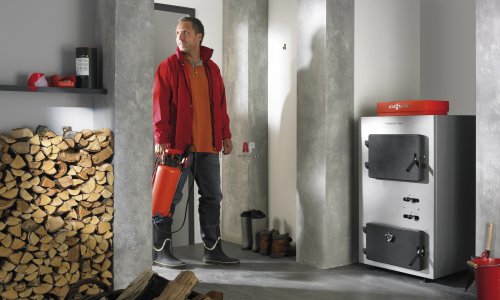
As a rule, firewood is given large number heat. Therefore, using them you can also heat the room, cook food and heat water if necessary. If we're talking about about heating big house with several rooms, then one boiler or stove will not be enough. Here special batteries or radiators will come to the rescue, which will distribute heat throughout all rooms from the main source installed in a certain place. Heat will circulate throughout the heating system. If desired, you can make such a system adjustable, which will allow you to heat some rooms and leave others cold.
Today, there are 3 main types of solid fuel boilers. These are pyrolysis units, classic devices and gas generator boilers. Each model has both its undeniable advantages and disadvantages. Classic installations are considered the most inexpensive and in demand. They are not that expensive, they work almost uninterruptedly and without serious breakdowns.
But still, the cheapest thing for a country house would be to acquire a regular wood-burning stove. This economical heating will help solve several problems at once. You can cook food and heat water on it. At the same time, the stove will perfectly warm the air in the room. And in regions with a particularly harsh climate, such a stove is convenient because you can also sleep on it.
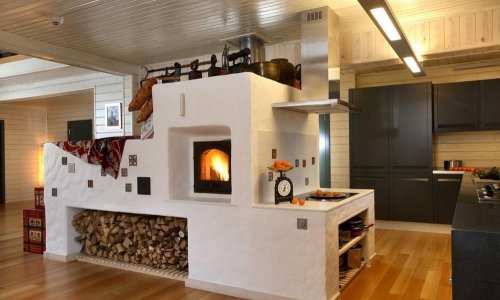
Figure 1. Wood-burning stove in a private house.
You can either build a stove in the house yourself, or invite a specialist who will assemble it according to finished project. It all depends on financial resources homeowner. If you approach this issue wisely, you can make a wood-burning stove that will not only be highly functional, but will also fit perfectly into the interior. An example of such an installation is shown in the photo (Figure 1).
But when choosing this heating option, some disadvantages should be taken into account. So, you will have to constantly load firewood into the oven. If coal is used, then this can be done a little less often. When using the stove, you will need to strictly monitor compliance with safety rules. Another significant disadvantage for many homeowners is that when using the stove you will need to constantly remove debris and ash. And this can only be done mechanically. Therefore, you will have to give up carpets in a room with a stove in advance.
How to heat a house without using electricity and gas has now become clear. Is it cheaper to do this? Such a question cannot be answered immediately. Here a lot will depend on related factors. But still, now there are many options for alternative heating. Therefore, you can always find the most suitable solution for yourself.
The use of natural gas is the most in an economical way heating a wooden cottage. Among all other alternatives, this fuel is inexpensive, and boilers based on it are extremely easy to operate. But how to organize heating of a private house without gas, because not everywhere there is main gas pipelines. What alternatives exist to this fuel, which option is the most profitable?
Methods for organizing heating in a cottage
The most common in domestic country houses The autonomous heating system for the home is water. It uses water heated in a boiler or furnace as a coolant. After heating, it releases heat to the rooms using radiators and pipes, creating comfortable conditions in them.
Heating systems, depending on the connection diagram of heating devices, are divided into:
- Monotube - with serial connection radiators, according to which the coolant is supplied and removed from the device using one pipe;
- Two-pipe - with supply and return lines and a sequential scheme for connecting devices to pipes, according to which the coolant is supplied to the device by one pipe and discharged by another.
Both types of heating systems come with upper and lower wiring types. The first option involves laying the supply pipe above the location of the coolant receiving devices, the second, respectively, below.
The arrangement of pipes relative to heating devices can be vertical or horizontal, on the basis of which the heating system takes on the technical term of the same name. The first type is used mainly in multi-story buildings or in one-story cottages with an attic, within which it is possible to install an expansion tank and lay a pipeline to supply coolant through a separate branch to each device.
A horizontal heating circuit is constructed in small private buildings. The reason is insufficient productivity and restrictions on length - the network cannot be more than 30 linear meters in length.
The risers are connected to radiators using a one-way or two-way scheme, i.e. with pipe connections on one or both sides. If in vertical single pipe system When the batteries are connected on one side, it is called a circuit with inverted circulation. The latter type is not recommended for systems with steel or cast iron appliances.
The main elements of a typical heating system in a private country house are: a heating boiler, radiators and coolant supply pipelines
Depending on the type of water circulation in the pipes, heating systems come in two types:
- Natural - imply gravity flow of the coolant due to the laws of physics.
- Forced - require the presence of a circulation pump to create a circulation of the thermal energy carrier from the boiler to the devices, and after cooling in the opposite direction.
First option easier than the second in design and installation. But the heat supply in a natural system cannot be automatically controlled; the coolant in it moves through the pipes due to gravity and the difference in densities of cold and heated water. But unlike the forced option, it is non-volatile.
If the power supply is turned off, the heating system with natural water circulation will continue to function properly if its main unit is a non-volatile boiler. There is also no pump that requires power from an outlet.
However, gravitational pressure has its limits. The heating power with natural circulation is simply not enough to supply coolant to branched circuits. Sometimes it is not enough to supply heated water with the temperature required for heating at a distance between the radiator and the boiler of 25 m, if the pipeline is made of a material with high hydraulic resistance: steel or cast iron.
If wooden house has a small area, then a natural system is quite enough for it. However, a large cottage of two or three floors requires a more powerful option with a pump that will pump hot water to all rooms remote from the boiler on all floors.
In addition to using gas, the coolant can be heated by electricity or by burning other types of fuel. Also independent heating in a private house where there is no connection to the gas main, it is often organized using convectors, infrared heaters and heat pumps.
The choice of a specific heating system design method depends on many factors. The climate of the region of residence, the quality of home insulation, as well as the availability of one or another type of fuel are important here.
Heating circuits with steam and heated air circulating through them are arranged according to identical principles.
Particularly worth mentioning is the “warm floor” system, which is a network of pipes with a circulating coolant under the floor covering. The main advantage of this option is that as a result of heat coming from below, the air in the room is optimally heated at the level of human height, and not somewhere under the ceiling.
Alternative to gas: choosing a water heating boiler
Natural gas is far from the only type of fuel for autonomous heating systems. Boilers also burn solid or liquid fuel as fuel. It is also possible to use electricity to heat water. Some people prefer traditional wood or coal stoves, while others prefer pure electricity. But it’s worth remembering that if there are power outages, electric boilers will be of no use.
Option #1: Solid fuel
Solid fuel stoves and more modern analogues boilers are an ancient and most popular method of heating private houses in areas without gas. These can be either traditional Russian stoves or modern boiler equipment industrial production with various automation.
The following are used as solid fuel:
- firewood;
- straw briquettes;
- peat;
- coal;
- wood pellets.
Such equipment is cheap and easy to use. Fuel is also not particularly expensive. However, as a result of its combustion, quite large volumes of ash are formed, which must be constantly disposed of. Plus, you have to visually monitor the operation of such equipment, which takes a lot of time.
On the one hand, the cheapness of fuel, and on the other, regular cleaning of the firebox and chimney pipes. There is no clear decision “for” or “against” here. But in the situation of living near coal deposits or near a forest, the choice in favor of solid fuel boilers or stoves is obvious for many, and often the only possible one.
You can safely consider a fireplace as an option for a solid fuel unit, although there is a strong opinion about its low efficiency. However, when installed correctly, a fireplace is not only a decorative element of the interior, but also good alternative gas boilers. Moreover, it is completely energy independent, which eliminates interruptions in heating in the event of any problems on the power grid.
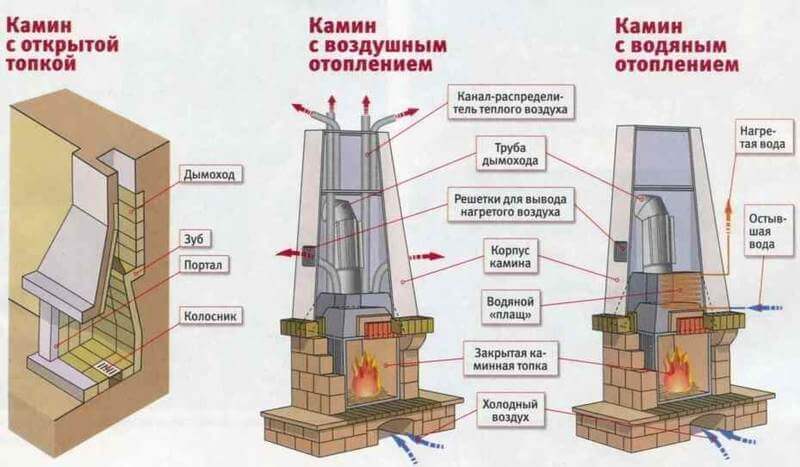
A traditional fireplace involves air heating exclusively of the room where it is located, but nothing prevents you from connecting pipes to it to heat the coolant
Most fireplaces are designed in such a way that they can only heat one room. However, the standard fireplace design can be supplemented with a coil around the chimney, which will heat water for the radiators of the heating system. Or you can immediately distribute warm air throughout the rooms using air ducts with adjustable dampers.
Fireplace heating is highly inert. To warm them up private house it takes a lot of time. Most best option- this is to light the fireplace constantly. However, in this case you will need a lot of firewood. But all these minor inconveniences are more than offset by the opportunity to observe the process of burning logs and the aesthetics of your own home.
Option No. 2: Liquid fuel
In terms of efficiency, liquid fuel (diesel) boilers differ little from their gas counterparts. However, they are larger and heavier. Their installation requires a separate non-residential premises. Installing them in a cottage under the stairs or in the kitchen is strictly prohibited.
When burning oils plant origin and petroleum products, significant volumes are formed harmful emissions. The boiler room for these installations must be equipped with high-quality ventilation and a smoke exhaust system. Plus, if installed and used incorrectly, they can start to smoke.
For heating private wooden houses they are used the following types liquid fuel:
- Kerosene.
- Diesel fuel.
- Development of fuel and lubricants.
- Fuel oil.
- Biofuel from vegetable oils.
Due to the specific smell and high probability In case of ignition, it is recommended to store such fuel outside the cottage. But in winter, liquids freeze outside, so you will have to make a separate heated room for such fuel or organize its preheating. And these are additional and significant expenses.
Among the advantages of using liquid fuel equipment for heating, it is worth noting high efficiency, no need to obtain permits for installation, and autonomy of operation. However, the high price of fuel outweighs all these advantages. Organize heating wooden house without gas using a diesel boiler is only worth it in cases where there is no other alternative, and it is not even foreseen in the future.
Option #3: Electricity
Electric boilers do not require a chimney. They are safe and compact in size. Heating of the coolant inside them occurs due to the heating element. Electric boilers can be used as both main and additional source thermal energy. They are easy to use and efficient, but heating with their help is quite expensive.
If the electrical networks in the village do not provide constant voltage, then choosing an electric boiler for heating your own wooden house is risky. At some point, you may be left without lighting and a heating system at the same time. The only option in such a case is a backup diesel generator.
The power allocated by power engineers is not always enough to fully heat a cottage. And installing an additional power supply line will result in serious waste of money. Installation and heating electrical equipment are relatively cheap, but the latter consumes a lot of electricity. If you plan to install heating in a private house without gas using an electric boiler, then you should prepare in advance for a serious increase in electricity bills.
How else can you heat a wooden house?
To create comfortable conditions In the cottage rooms you can use other heating methods. There are now a lot of new products on the autonomous heating equipment market. Some of them have a high price, but have high efficiency. And others involve the use of alternative energy sources.
Infrared Heating Options
The main feature of IR heat sources is that they heat not the air, but objects and surfaces in the heated room. Already from heated furniture, walls and floors, heat is transferred to air masses into the room. As a result, with minimal energy consumption, it is possible to create the most comfortable conditions in your home.
Electric heaters with infrared radiation are sold as:
- suspended panels in housings various shapes;
- film devices for installation on the ceiling or floor;
- floor-standing models (a la a regular radiator).
IR heaters operate in automatic mode. Just plug them into a power outlet and set them to the desired temperature. Installation of wall and ceiling models is extremely simple; all necessary fastenings are provided in the housing or on the film. Only the installation of a “warm infrared floor” can cause difficulties. But if you strictly follow the instructions, everything is done in an elementary way.

Film heaters under the ceiling are an excellent alternative to gas boilers: economical, does not burn oxygen in the room and is completely safe from the point of view of fires
IR heaters allow you to quickly create a reliable and effective system heating in any private house where there is no gas. When compared with an electric heating boiler, they provide savings of 30–40%. Moreover, the heating of the rooms occurs an order of magnitude faster, almost instantly.
Infrared heating devices can be used as the main source of heat or complement other heating systems for the cottage. The diversity of the model range makes it possible to fit them into any interior, and, if necessary, quickly increase the thermal power.
Among negative aspects IR electric heaters – static electricity, which attracts dust, and the initial capital investment is considerable. Nothing much can be done about statics, and the cost of equipment is always recouped due to low energy consumption.
Heat pumps as a useful addition
Among the alternatives to gas when heating a wooden house, heat pumps stand out, extracting it from the subjects environment. Structurally and technically, this is an air conditioner in reverse. Only the heat pump does not cool the air, but heats it. Moreover, everything necessary for this thermal energy it generates thanks to the judicious use of free natural resources and phenomena.

Heating based on a heat pump for a private house without gas is the maximum saving on energy resources. But in our latitudes, this type of heating can only serve as an addition to the main heating network
The disadvantage of heat pumps is their dependence on the presence of voltage at the outlet. They will not work without a constant power supply. Plus, in severe frosts their effectiveness decreases sharply. In warm regions with winter temperatures around zero, their performance is excellent, but in Siberian conditions they are of little use.
Low potential heat heat pumps can collect from:
- street air;
- land through wells or pipe systems in the ground;
- water (any nearby reservoir or wells).
Heat pumps are good for everyone. However, you have to pay a lot for “free” energy by purchasing expensive equipment. For a large house, costs can exceed a million rubles.
Solar energy and wind turbines
Another option for “green” energy is solar panels and collectors. The former generate electricity, and the latter, using the rays of the sun, heat the coolant for supply to the intra-house heating system. They do not require any gas to operate; they only need a constant wind and cloudless weather.
In the future, electricity and heated coolant can be used to heat a private home by installing a heating system with radiators and various electric heaters. Solar power plants are generators of electrical and thermal energy. The heating of the rooms itself is carried out thanks to a variety of heating devices that are connected to these generating devices.
In turn, wind generators convert wind energy into electricity. And then the heaters are connected to the power supply.
The main disadvantage of all these clean energy sources is that they depend on external factors. Cloudy weather and calm negates their effectiveness. As an additional source, they are a completely suitable option for heating a private house without gas, but it is not worth building the entire heating system on them alone.
Which heating is the most economical?
From the point of view of fuel costs, the most economically profitable option after mains gas is the option with firewood. It is difficult to find cheaper fuel for boilers, stoves and fireplaces. Then comes coal, and then electricity and diesel. In the case of alternative energy, the costs for this item are generally zero or minimal. However, we should not forget here about the cost of thermal engineering units for generating heat.
Based on the totality of all costs, it is cheaper to heat a house without gas using electricity. But this only applies to cottages with good insulation, as well as situations where the power of existing networks allows connecting electrical heating equipment. In other situations, it is better to opt for more traditional solid fuel stoves or boilers. published
The warmth of an apartment or a country house on cold autumn-winter days always means coziness, a comfortable feeling, good rest, productive work. More ancient man“tamed” the fire, forcing it to warm the home. Modern world invented new methods of heating, possible only in civilization - with the help of gas and electricity. But the need for heating without gas remains relevant to this day, meeting the needs and capabilities of a fairly large part of the population.
How to cheaply heat your home
There are a great many options for heating units and systems. Most of them convert the energy of fuel combustion into thermal energy, facilitating the best distribution of warm air indoors.
Types of heating
The heating of high-rise apartments is most often central, although many houses are now switching to autonomous systems, which is considered much more profitable in terms of quality and economically. In low-rise buildings, private country houses, and dachas, heating can be installed:
- Also steam central,
- Autonomous gas or electric,
- Stove using various types of fuel,
- Fireplace.
You can install heating without pipes and communications, consisting of only one heating device, so the whole system with batteries and pipe lines.
Cheapest fuel
Heating devices can use various fuels - solid, liquid, gaseous, electronic. At the same time, its traditional types are not always more convenient or cheaper for the consumer:

Stove complex with fireplace
- Electricity is the most in a simple way heating organization, but also one of the most expensive,
- Gas heating cheaper, but you need to take into account that the main and liquefied gas- these are slightly different things, since the basis of centrally supplied gas is methane, and the substance in the cylinders is propane-butane, the combustion of which is 4-5 times more expensive;
- Diesel fuel is also quite an expensive pleasure (1 Gcal of heat will cost more than 3.5 thousand rubles), which creates bad smell near the heating apparatus, although it may become an accessible alternative to centrally supplied fuels,
- Coal is a fairly cheap fuel, with which heating will cost 3-4 times less than with diesel fuel (1 Gcal of heat will cost about 1 thousand rubles),
- Peat supplied in briquettes is approximately 1.5 times more expensive than coal,
- Firewood will be quite cheap, but it’s worth considering that it’s not always convenient to use, and it burns out much faster than coal,
- Pellets - granules based on wood waste - will give 1 Gcal for about 1.5 thousand rubles, and they are convenient to use for boilers where fuel is supplied automatically.
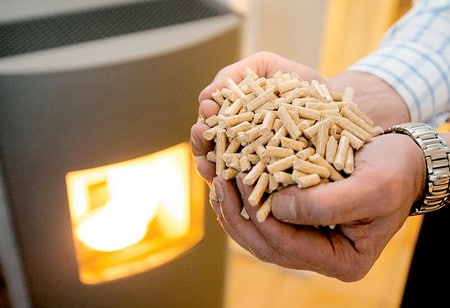
Pellets - alternative fuel
Alternative heating options
Without electricity and gas
In the event of a temporary or permanent absence of the types of fuel to which we are accustomed, it is quite possible to arrange heating at home without electricity and gas. As you can see from the above, if you replace them with something else, you can even save money. The options here could be the following:
- Of course, stoves and fireplaces - wood, coal, etc. Choosing this option will require the construction of an appropriate brick structure or the purchase of a ready-made unit. At the same time, you will get an environmentally friendly method of heating, and with some of these stoves, even cooking thanks to the presence of a stove (oven or broiler).
- The original method would be heating from own source electricity. There are two ways to autonomously generate electricity:
- From sunlight. To do this, you need to purchase solar collectors that convert the sun's energy into heat (a sort of “heater without electricity”) and electricity. Of course, you will have to spend money on purchasing equipment, but then you will be able to get heat and light without spending much money.
- From wind energy. You can buy a ready-made device that converts it to generate electricity, or you can assemble it yourself. The circuit is quite simple: windmill (spinner), generator, battery.
Such methods of obtaining heat are very beneficial for suburban and country houses in areas where gas pipelines do not pass, especially for rarely visited households (dachas).
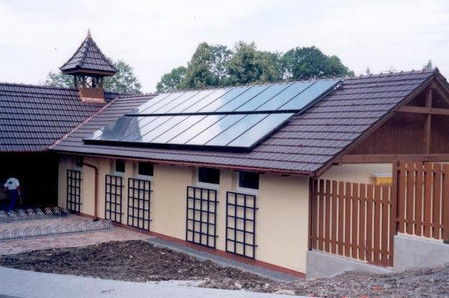
Solar collector installed on the roof of a house
Without pipes and boilers
The heating device can be equipped with a boiler with a pipe-radiator communications system connected to it to heat several rooms at once (depending on the power of the device). But with no less success, you can have heating without boilers and pipes, consisting of only one heat source. Usually this is:
- A metal or brick stove with the function of heating one or two adjacent rooms,
- Fireplace, like for medieval castles,
- Electric heater (oil, reflector, heat gun),
- At worst, the heating function of appliances such as air conditioners, etc. may be suitable.
INTERESTING! For houses built on the model of ancient Russian “five-walled houses,” one heat source in the form of a stove located right in the middle, between two adjacent rooms, is more than enough. Even now, steam heating with pipes and radiators is not provided in such houses.
Heating without fuel
Modern scientists have invented a way to heat a house even without burning any fuel resources - the so-called “heating without fuel.” This is achieved through the operation of a unique device – a heat pump.
Design and operation
The heat pump consists of tubes filled with freon, as well as several chambers - throttle, compressor, heat exchange. The operation of the device is similar to that of a refrigerator. It is called by scientists after its inventor the “Carnot cycle,” which is based on simple laws of physics:
- Liquid freon passes through tubes lowered deep into the ground or reservoir, where the temperature even in winter remains up to +8 0 C. There it becomes a gas, since its boiling point is only +3 0 C.
- Rising upward again, the freon gas enters the compressor chamber, where it is strongly compressed, which is quite easy to do with a gaseous substance. As you know, compression of any substance in a limited space leads to its heating, so freon heats up here to approximately 80 0 C.
- Transferring the resulting heat through the heat exchanger to the heating system, the freon passes to the throttle chamber, where its pressure and temperature decrease, turning it back into liquid.
- Next, the liquid freon is sent back to the depths of the earth to warm up, repeating the cycle again.
IMPORTANT! Of course, the heat pump still requires electricity to operate, but its amount is disproportionately less than with direct electrical heating of the coolant.
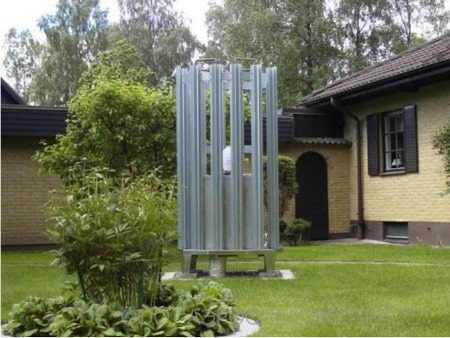
Types of heat pumps
Heat pumps differ in the way the freon is heated before turning into gas, that is, in the source of “low-level heat”:
- Water for installation near ground-based reservoirs,
- Water to receive heat from groundwater,
- Earthen,
- Airborne.
The name of the device also includes the type of coolant in the heating system you have installed, that is, the passport for it must contain the words: “soil-water”, “water-water”, “soil-air”, etc.
Warmth without heating
Finally, if the creation of any heating system is impossible for technical, economic or other reasons, or there is simply no point in doing it, because the heat will be “just around the corner,” then it is possible to warm up at home for some time without heating.
There are several methods of such heating; they can be used individually or all together:
- Insulating the home will retain the crumbs of heat received from cooking, breathing of residents, etc. This includes not only construction changes, but also the addition of warm carpets, heavy curtains and the like. It’s worth doing this in any case, even if your heating is in perfect order: this way you can save energy resources.
- Insulate yourself: an extra sweater, a warm blanket, a fur cape on a cold evening can help you.
- We apply additional methods warming: hot tea and a heating pad can really warm you up.
- Let's warm ourselves up psychologically: change the color scheme of the room to a “warmer” one with yellow-brown combinations, add knitted and wooden accessories. You can put up photo wallpaper with a sunny picture or light an aroma candle with a pleasant warm smell. At the same time, we influence not the sense of touch, but the organs of vision, thereby deceiving our body and making us feel warm.
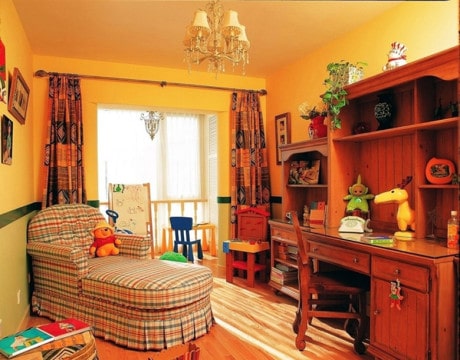
Warm colors in the interior
Be that as it may, if you wish, you can find suitable way warm your home and your loved ones even in severe frosts. We hope that the methods we have described will help in any situation, under any opportunities and circumstances.
Video: how to heat an apartment for free





